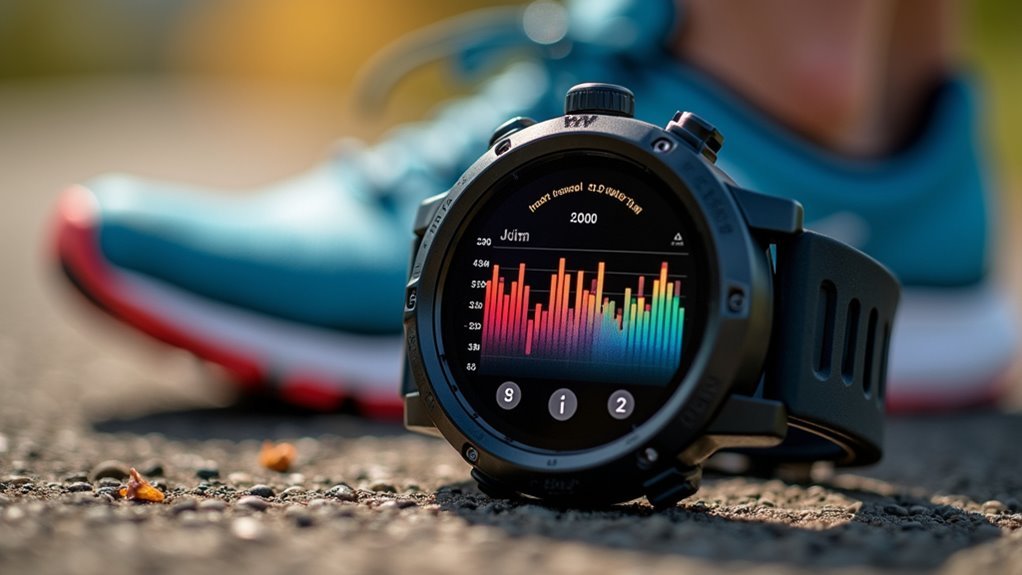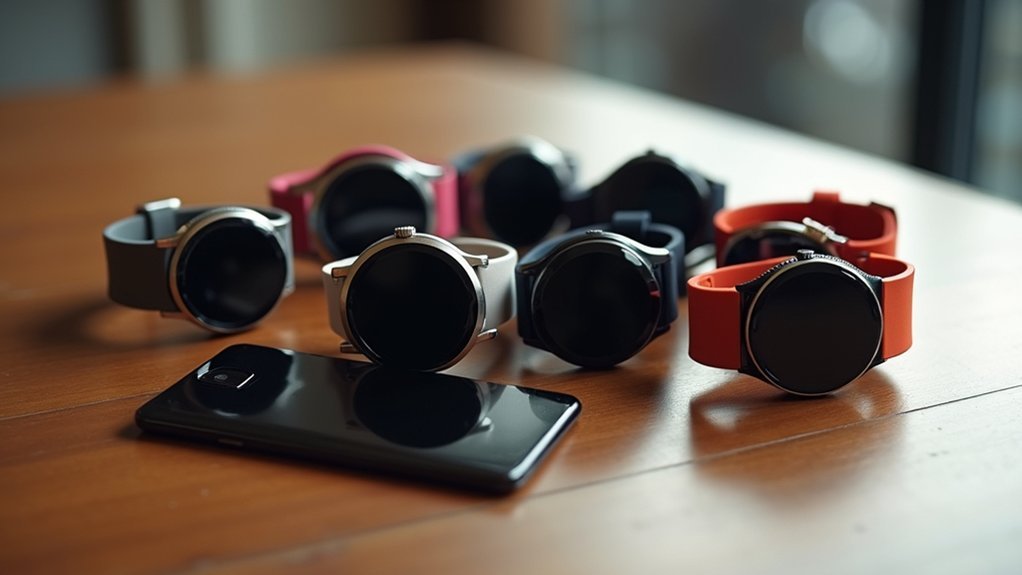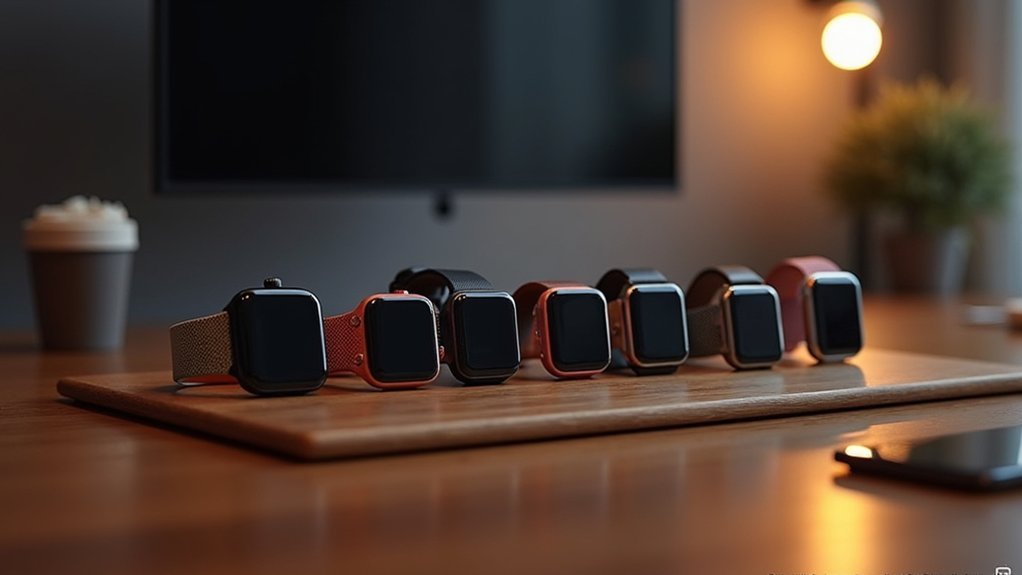Your sport watch’s pixel density directly impacts how clearly you’ll see essential performance data during workouts. With most premium models offering 300-350 PPI, higher pixel density guarantees sharp text and graphics that remain readable in bright sunlight or low-light conditions. You’ll experience less eye strain and can quickly access crucial metrics like heart rate, pace, and navigation without squinting at pixelated displays. Understanding these technical factors will help you choose the best device for your athletic needs.
The Science Behind Pixel Density in Sport Watches
When you glance at your sport watch mid-workout, the crispness of those tiny heart rate numbers and GPS maps depends entirely on pixel density—the concentration of individual pixels packed into each square inch of your display.
Measured in pixels per inch (PPI), this metric determines how sharp and detailed your watch’s visuals appear. You’ll find most sport watches deliver between 300-350 PPI, like the Google Pixel Watch’s 320 PPI or LG Watch Sport’s 348 PPI.
Higher pixel density means more information fits clearly on your screen without pixelation. This becomes essential when you’re checking complex health data, navigation details, or notifications during intense activities where quick, accurate readings matter most. Advanced sport watches with aerospace-grade titanium construction often pair premium materials with equally premium display technologies to ensure durability matches visual performance.
Enhanced Readability Under Challenging Conditions
When you’re pushing through an intense outdoor workout, your sport watch’s pixel density becomes essential for maintaining clear visibility in challenging lighting conditions.
Higher pixel density guarantees you can read your metrics clearly whether you’re squinting against bright sunlight during a midday run or checking your pace in the dim light of early morning training sessions. Modern displays now achieve 2,000 nits maximum brightness, ensuring exceptional readability even in the most demanding outdoor conditions.
You’ll find that enhanced pixel density directly impacts how effectively your watch performs when environmental factors would otherwise compromise screen readability.
Sunlight Visibility Improvements
Although sport watches excel in controlled indoor environments, their true test comes under the harsh glare of direct sunlight where traditional displays often become unreadable.
High pixel density dramatically improves your ability to read the screen outdoors by creating sharper, crisper text and graphics that cut through bright conditions. When you’re running or cycling, those refined edges and clear numbers reduce eye strain while enabling quick data interpretation without breaking stride.
Higher resolution displays maintain clarity even when brightness reaches 2,000 nits, preventing the blooming effects that plague lower density panels. Modern fitness watches like the Apple Watch Ultra achieve this 2,000 nits brightness level, ensuring readability even in the most challenging outdoor lighting conditions.
You’ll notice better anti-aliasing and contrast, both critical when sunlight competes with your display’s light. Larger usable screen sizes combined with dense pixels let you see bigger display elements without sacrificing sharpness.
Low Light Performance
Three critical factors determine how well you’ll read your sport watch display when ambient light drops: pixel density, contrast ratios, and display technology. Higher pixel density notably enhances text sharpness, making metrics easier to decipher without cranking up brightness. AMOLED displays excel here, delivering superior contrast that helps distinguish data elements clearly.
Key low light performance benefits include:
- Enhanced readability without brightness adjustments
- Reduced screen reflectivity minimizing glare issues
- Auto-brightness features optimizing visibility automatically
- Better battery efficiency through lower power requirements
- Improved color accuracy for data differentiation
You’ll find that watches with advanced display technologies maintain excellent visibility while conserving battery life. The combination of high pixel density and quality OLED technology ensures you won’t miss critical information during early morning runs or evening workouts. Premium models like the Garmin Forerunner 265 and Suunto Race showcase how AMOLED displays provide exceptional clarity even in challenging lighting conditions.
Visual Performance Tracking for Athletic Excellence
Since modern sport watches pack increasingly higher pixel densities into compact displays, you’ll find that crystal-clear visuals have become essential for tracking your athletic performance in real-time.
High pixel density guarantees you can read detailed metrics like heart rate, step cadence, and stride length without squinting or losing focus during intense workouts.
Crystal-clear displays deliver instant access to vital performance data when every second of your workout counts most.
When you’re pushing your limits, every data point matters. Sharp displays let you monitor ground contact time, stride height, and motion patterns with precision.
You’ll make split-second adjustments to your technique based on accurate visual feedback. Whether you’re analyzing post-workout data or checking real-time performance metrics, crisp visuals prevent misreading critical information that could impact your training decisions and athletic development.
Premium models with AMOLED displays deliver exceptional brightness and contrast, making it easier to view complex training analytics and performance data even in challenging outdoor lighting conditions.
Display Technology Comparison: LED, LCD, and OLED
When you’re choosing a sport watch, the display technology directly impacts how well you’ll read performance data during workouts. Each technology offers distinct advantages for athletic performance tracking.
Here’s how the main display technologies compare for sports watches:
- OLED/AMOLED: Delivers superior contrast, vivid colors, and exceptional sharpness – ideal for detailed maps and performance metrics.
- LCD: Provides excellent sunlight visibility and wide viewing angles, though it lacks OLED’s contrast levels.
- LED: Rarely used as standalone displays due to power consumption and visibility limitations.
- Resolution advantage: OLED displays typically offer higher pixel density and sharper detail than LCD alternatives.
- Premium choice: High-end sports watches like Garmin Fenix series prefer AMOLED for crisp readability in various lighting conditions.
You’ll find OLED technology delivers the clearest data visualization during intense activities. The Coros Pace Pro features an AMOLED display that provides excellent clarity for runners tracking performance metrics.
Impact on Battery Life and Power Efficiency

When you’re choosing a sport watch, you’ll face a critical trade-off between high pixel density displays and battery longevity, as denser screens consume considerably more power to maintain their sharp resolution.
You can maximize your watch’s endurance by implementing smart battery optimization strategies like reducing the on-pixel ratio during always-on display modes and adjusting brightness levels based on your environment.
Modern sport watches now integrate energy-efficient technologies such as variable refresh rates and machine learning algorithms that automatically optimize power consumption without sacrificing the display quality you need during workouts. Advanced displays with peak brightness of 2,000 nits can now deliver exceptional visibility in bright outdoor conditions while maintaining power efficiency through adaptive brightness controls.
Display Power Consumption Trade-offs
The display technology you choose for your sport watch directly impacts how long your battery lasts between charges. Different display types create varying power demands that affect your watch’s performance throughout the day.
AMOLED screens generally consume less power than IPS displays because they don’t need backlights. However, pixel density creates additional considerations:
- Higher pixel density increases power consumption due to more pixels requiring electricity
- OLED displays save energy by turning off black pixels completely
- Always-on display modes should maintain less than 15% on-pixel ratio
- Larger displays with higher resolutions drain batteries faster unless optimized
- LTPO backplane technology helps by dynamically adjusting refresh rates
Sport watches using MIP technology can achieve significantly longer battery life by retaining pixel states without constant power refresh. You’ll need to balance display quality with battery performance based on your specific usage patterns.
Battery Optimization Strategies
Five key areas determine how efficiently your sport watch manages battery life, and understanding these enhancement strategies can extend your device’s runtime by 30-50% during typical use.
First, you’ll want to adjust GPS settings by switching to UltraMax mode and extending intervals from 5-second to 60-second tracking when precision isn’t critical.
Second, simplify your display by reducing brightness, disabling always-on features, and choosing watch faces with lower on-pixel ratios.
Third, minimize unnecessary features like vibrations, activity alerts, and navigation maps when they’re not needed.
Fourth, remove unpaired accessories and heart rate straps during non-training periods. For ultra marathons and Ironman races, these battery optimization techniques become even more critical since standard entry-level watches typically last only 8-10 hours while events can extend well beyond this timeframe.
Finally, maintain effective charging practices and keep your software updated for maximum efficiency.
Energy Efficient Technologies
Beyond manual optimization techniques, sport watches now incorporate advanced energy-efficient technologies that automatically enhance battery performance while maintaining high-quality displays and functionality.
MicroLED displays represent a breakthrough in power management, delivering 30-40% energy savings compared to older display types. Meanwhile, higher energy density batteries store more power in compact spaces without adding bulk to your wrist. These innovations work together to maximize your watch’s endurance.
Key energy-efficient technologies include:
- MicroLED displays reducing component energy consumption by up to 40%
- Dynamic pixel management adjusting refresh rates based on content needs
- High energy density batteries storing more power in smaller volumes
- Low-power co-processors handling sensor data efficiently
- Adaptive display brightness automatically optimizing power usage
You’ll benefit from longer battery life while enjoying crisp, detailed visuals during your workouts. Modern sport watches like the Apple Watch Series 9 demonstrate superior processing power through their advanced chip architecture, enabling these energy-efficient features to work seamlessly together.
Market Competition and Consumer Expectations
How do smartwatch manufacturers stay ahead in a market projected to grow from $91.01 billion in 2024 to $106.5 billion in 2025?
They’re focusing on display quality as a key differentiator. You’ll notice brands emphasizing higher pixel density because consumers expect sharp, clear visuals for health data and notifications. This technological advancement directly addresses your demand for better user experiences.
Manufacturers recognize that you want customizable watch faces and advanced health features displayed with crystal clarity. Major companies like Apple Inc. and Samsung are leading this charge alongside emerging brands competing for market share.
They’re competing by integrating AI-driven insights, improved sensors, and fashion-tech collaborations. You’re driving this competition through your expectations for personalization, durability, and multifunctionality.
The brands that deliver superior pixel density alongside energy efficiency and waterproofing will capture your attention in this highly competitive landscape.
Design Constraints and Display Size Optimization
When you examine sport watches closely, you’ll discover that manufacturers face a delicate balancing act between cramming pixels into tiny displays and maintaining comfortable wearability.
Physical constraints directly impact what’s achievable in pixel density optimization.
Design challenges include:
- Form factor limitations – Small watch faces restrict available space for high-density components
- Battery trade-offs – Higher pixel density displays consume more power, reducing battery life
- Manufacturing costs – Advanced microfabrication for dense pixels requires expensive technologies
- Thermal management – Dense pixel arrays generate heat that affects device performance
- Bezel reduction opportunities – Minimizing bezels can increase screen area by 40% without enlarging the watch
You’ll find the sweet spot occurs when manufacturers optimize screen size against pixel density while considering your viewing distance and typical sports usage patterns. Proper pixel uniformity ensures consistent brightness and color performance across the entire watch display surface.
Future Innovations in Sport Watch Display Technology
As sport watch technology rapidly evolves, you’ll witness revolutionary display innovations that transform how these devices deliver information during athletic activities.
Future OLED and microLED technologies will deliver pixel densities exceeding 400 PPI without draining your battery, while advanced coatings guarantee perfect visibility in direct sunlight.
You’ll experience augmented reality overlays that seamlessly integrate game stats, biometrics, and real-time coaching feedback directly on your watch screen.
AI-powered personalization will automatically adjust your dashboard based on activity, location, and performance data, creating actionable insights you can act on immediately. Advanced computer vision technology will analyze your movements in real-time to provide instant feedback on technique improvements and performance optimization.
Next-generation materials like self-healing screens and sapphire glass will maintain crystal-clear displays even in extreme conditions.
With 5G connectivity, you’ll stream HD video, detailed maps, and instant coaching feedback, making your sport watch an indispensable training companion.
Frequently Asked Questions
Can I Replace My Sport Watch Screen to Upgrade Pixel Density?
You can’t typically upgrade your sport watch’s pixel density through screen replacement. Replacement screens usually match original specifications. Higher pixel density requires different hardware architecture that isn’t compatible with your existing watch.
Do Higher Pixel Density Watches Scratch More Easily Than Lower Density Ones?
Pixel density doesn’t directly affect scratch resistance. Your watch’s scratch susceptibility depends on the glass material and protective coatings, not pixel count. Higher-density displays need quality protective glass to prevent scratches.
Which Sport Watch Brands Offer the Highest Pixel Density Displays Currently?
You’ll find Garmin and Polar leading with 454×454 pixel displays in models like the Fenix 8 and Grit X2 Pro. Apple’s Watch Ultra 2 also offers exceptional resolution, though they don’t publicize specific density figures.
How Do I Clean High Pixel Density Sport Watch Screens Properly?
Use a microfiber cloth with glasses cleaning spray, wiping in one direction. Avoid harsh chemicals and excessive pressure on the delicate pixels. Don’t let water enter the case while cleaning.
Are There Any Health Concerns From High Pixel Density Sport Watch Displays?
You won’t face significant health concerns from high pixel density sport watch displays. Higher density actually reduces eye strain by improving visual clarity. However, you should still limit prolonged exposure to minimize EMF radiation effects.
In Summary
You’ll find that pixel density directly impacts your athletic performance monitoring and training effectiveness. When you’re pushing your limits during intense workouts, you can’t afford to squint at blurry displays or miss critical data points. Higher pixel density guarantees you’ll read metrics clearly in any lighting condition, from bright sunlight to dimly lit gyms. It’s not just about premium features—it’s about maximizing your training potential through superior visual clarity.





Leave a Reply